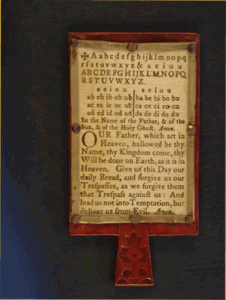An Early (Sometimes Edible!) School Book
Listen to the Recess! Clip
| Author | Rita Smith |
| Air Date | 9/4/2003 |

An Early (Sometimes Edible!) School Book Transcript
A hornbook was what children used in the 16th, 17th and 18th centuries to learn their ABC’s and to learn to read. Actually, it wasn’t a book at all, but rather a quarter-inch slab of oak wood cut into the shape of a rectangle, measuring about 4 by 6 inches, with a handle at one end. A printed sheet of paper was glued onto one side of the flat surface and, to prevent the paper from getting torn or dirty, it was covered with a thin sheet of transparent animal horn, hence the name, hornbook. Narrow, thin, brass strips were placed around the four edges of the paper and secured with small iron tacks.
In the upper left hand corner of the printed sheet was a cross, followed by the entire alphabet in both upper and lower case letters, followed by the five vowels, and an ampersand. The remainder of the sheet was filled with the Lord’s Prayer, and, if there was room, the numbers from one to nine, a table of syllables, or the invocation to the Trinity was included.
Wooden oak hornbooks were the least expensive and within the financial reach of almost everyone, but there were also other materials used to make horn- books. Silver was popular with those who could afford it. The base of these horn- books was a thin piece of wood, beveled at the edges, with a sheet of silver backing that wrapped around the edges and overlapped the front about a quarter inch. The front border was scalloped and the back etched with a pictorial or decorative design or composed of a fine silver filigree. There were hornbooks made of boxwood, with the letters burned into the wood, and some made of thin rectangles of ivory or bone, with engraved lettering instead of the printed sheet. Probably the most popular hornbooks among the youngsters themselves were the occasional ones made out of gingerbread. That’s right, gingerbread, with letters made of icing. This hornbook was larger and thicker than the ordinary ones, highly prized and rapidly consumed. When the student learned a letter, he was allowed to eat it. The producers of these hornbooks, you might say, inspired in young scholars a genuine taste for learning.
Millions of hornbooks were made and sold both in Great Britain and the American colonies, but by 1800, as tri-fold booklets with pictures became available, the demand for them diminished rapidly. By the end of the 19th century, hornbooks had not only gone out of style, but most of them had been physically destroyed. Andrew Tuer, who wrote a history of the hornbook in 1897, mourned its fate. “In its later days,” he writes, “the humble hornbook was treated with the full measure of contempt lavished on a thing which has served its purpose. ‘Destroy and forget,’ said everybody, and alas! Everybody did.” (Tuer, p. 6)
Source:
Tuer, Andrew W., History of the Horn-Book, London: Leadenhall Press, 1897.